Easy Sourdough Starter
This Easy Sourdough Starter recipe creates gorgeously fluffy homemade products such as Sourdough Baguettes. Included are simple step by step instructions on how to start, feed and Maintain Sourdough Starter that is perfect for beginners.
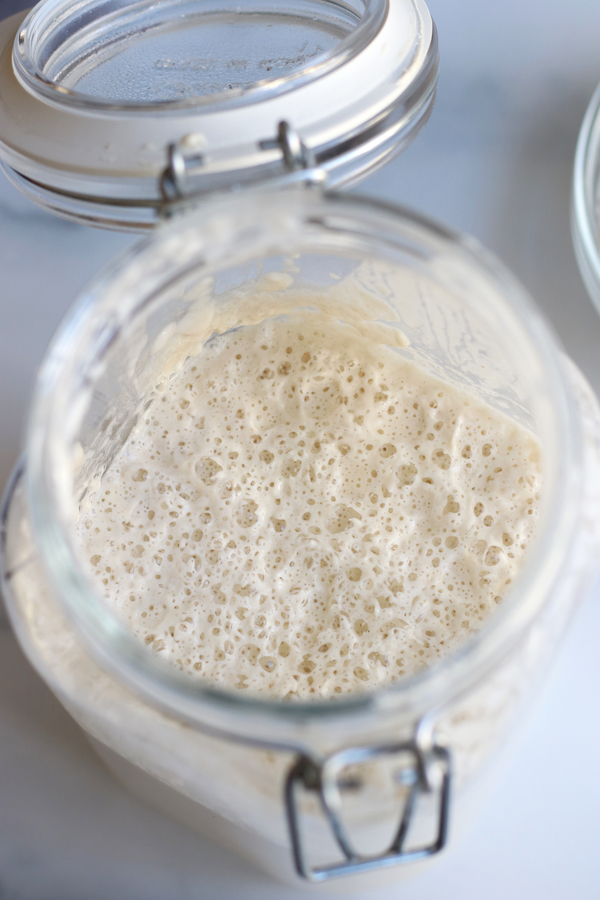
This post may contain affiliate links which I earn a small portion in sales if a purchase is made. Rest assured though, it is never at any additional cost to you.
What is Sourdough Starter
Very simply, sourdough starter is a fermented mixture of two ingredients, water and flour. Wild yeast found in flour flourishes when added to water and is allowed to rest in between feedings. This approach is the old fashioned way of making bread that has been done for centuries. It does require more time than active-dry or instant yeast but produces exceptional taste and textured baked goods.
Tools Needed
In addittion to the flour and water a few tools are needed to make your own from scratch Sourdough Starter.
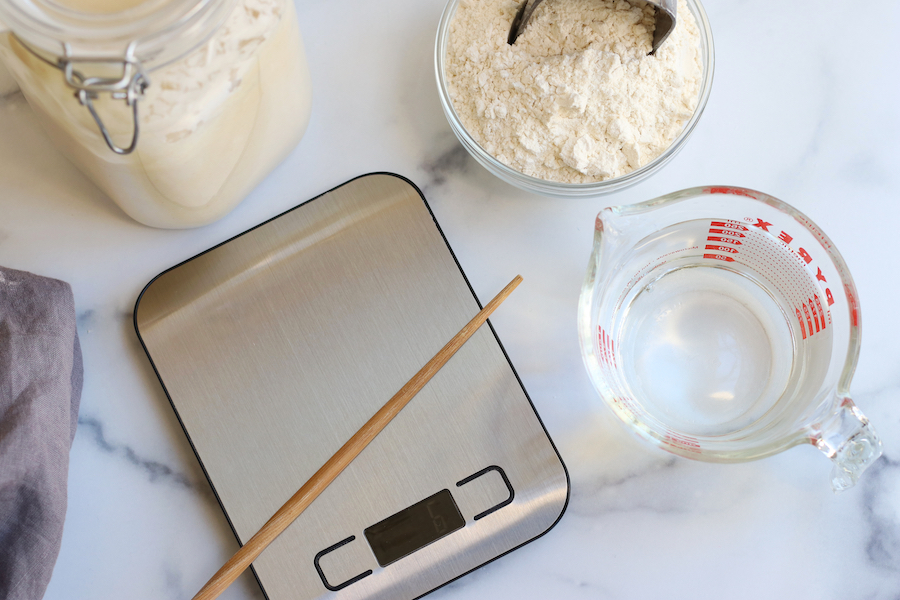
- Kitchen Scale- It is highly encouraged to use a kitchen scale to weigh the flour and water in equals parts to achieve the best results. This is the scale shown in the picture above. However, my next kitchen scale will be a little larger to accommodate the large bowl needed to make sourdough bread.
- Chopsticks– This makes stirring the starter in a glass jar much easier.
- Glass Measuring Cup– Makes for easy pouring of water.
- Scoop or Spoon– Helps with the addittion of flour.
- Medium Sized Glass Bowl– The first few days of a starters life is easier done in a medium size glass bowl.
- Plastic Wrap or Reusable Food Wraps– For the first few days of the starters life.
- Glass Jar (see below)
Sourdough Starter Container
The type of glass jar needed will depend on which type of flour you use to make your starter and how rapidly your starter ferments. This is the jar seen in the photo below and it works beautifully when using white all-purpose flour. Please see section directly below (White Flour vs Wheat Flour) for more explanation.
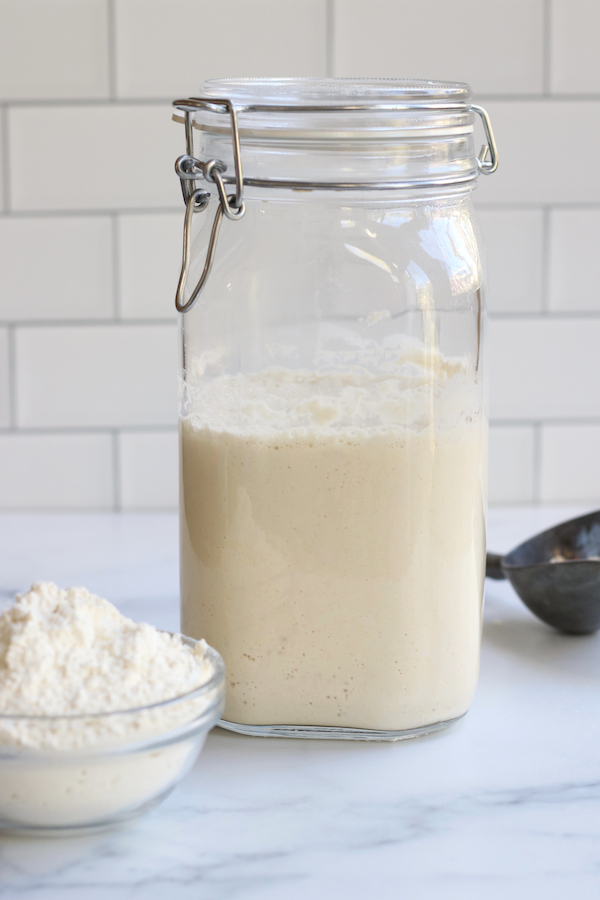
Best Flour for Sourdough Success
For the best sourdough starter, you need flour you can trust. Buying directly from King Arthur Flour means guaranteed freshness, expert-tested quality, and no risk of warehouse mishandling. Plus, you’ll find exclusive products, better stock availability, and support an employee-owned company dedicated to bakers. Skip the third-party markups and get the best right from the source. You and your sourdough deserve it! (affiliate)
White Flour vs Wheat Flour
The type of flour used will have a great influence on how your Stater ferments and the final product that you make with it. However, it is most important to not choose bleached flour as this will impede the fermentation.
All-Purpose White Flour
I adore sourdough bread that bites me back when I eat it. In other words, extra sour with a tang. However, my husband HATES that kind of bread. That is why I use all-purpose white flour for my Starter.
This type of flour yields breads that are very much like a crusty Italian loaf that he and I both go crazy for. Additionally, I use the Starter from this type of flour for making baguettes that then make incredible Homemade Breadcrumbs and croutons. The final products are never overly sour.
Wheat or Rye Flour
Wheat and rye flour has more naturally occurring wild yeast. Because of this, the starter made from these types of flours will ferment faster and with more intensity. It is very important to keep a closer eye on Starters made from these flours and to use a glass jar that has a lid that is looser or can be left slightly open. The reason for this, a tight fitting lid could be a recipe for an exploding jar.
In conclusion, wheat and rye flours will make much stronger sourdough products and all-purpose white flours (unbleached) will yield more mild final products.
How To Make
To make Sourdough Starter that is ready to bake with will take approximately 7 days, give or take a day or two. Here are the instructions for each day.
Day 1
In a medium sized glass bowl mix together 50 grams of water and 50 grams of flour. Stir well and cover. Let sit at room temperature.
Pro Tip#1– To accurately weigh the flour and water start by making sure the scale is weighing in grams vs ounces. Place the bowl on the scale and turn on. The scale should read zero with the the bowl on top. Add enough flour to equal 50 grams. Calibrate the scale back to zero again and repeat with water.
Pro Tip#2– In the making and feeding of this starter there will always be equal parts of flour and water added to it.
Day 2
To yesterday’s mixture add 50 grams of flour and 50 grams of water. Stir well and cover. Let sit at room temperature.
Day 3
Throw away half of the Starter. To the remaining Starter add 100 grams of flour and 100 grams of water. Stir well and cover. Let sit at room temperature.
Pro Tip#3– The discarded Starter from day 3- day 6 is not fully developed enough to have any uses. Simply throw it away.
Day 4
Throw away half of the starter. Add 150 grams of flour and 150 grams of water to the bowl and stir well. Cover and let sit at room temperature.
Pro Tip#4– Day 4 is the day that you will notice the mixture starting to take on the personality of a Sourdough Starter. There should be small bubbles and a slight sour smell will start to take shape.
Day 5
Similar to the previous days, throw away half of the Starter and add 150 grams of flour and 150 grams of water. Stir well, cover and let sit at room temperature.
Pro Tip#5– The Starter should begin to look very similar to picture A below. If not do not worry, it will very soon. Also, feel free to transfer to the glass jar once the new flour and water its mixed in on day 5.
Day 6
Throw away half of the starter and add 200 grams of flour and 200 grams of water. Stir well, cover and let sit at room temperature.
Pro Tip#6– By day 6 the Starter should look similar to photo A below and very possibly look like photo B.
Day 7
On day 7 the Starter should at the least look like photo B if not like photo C. If it has a similar appearance to photo C, it is ready to use. If it looks like photo B, let it sit at room temperature for one additional day.
Feeding and Reviving Sourdough Starter
Above all, if your Starter looks like photo C it is ready to be used for making all kinds of sourdough products. If it looks like photo B, you can still use it for baking. However, it will slow down the rising of bread dough. When it looks like photo A, it is time to feed the Starter.
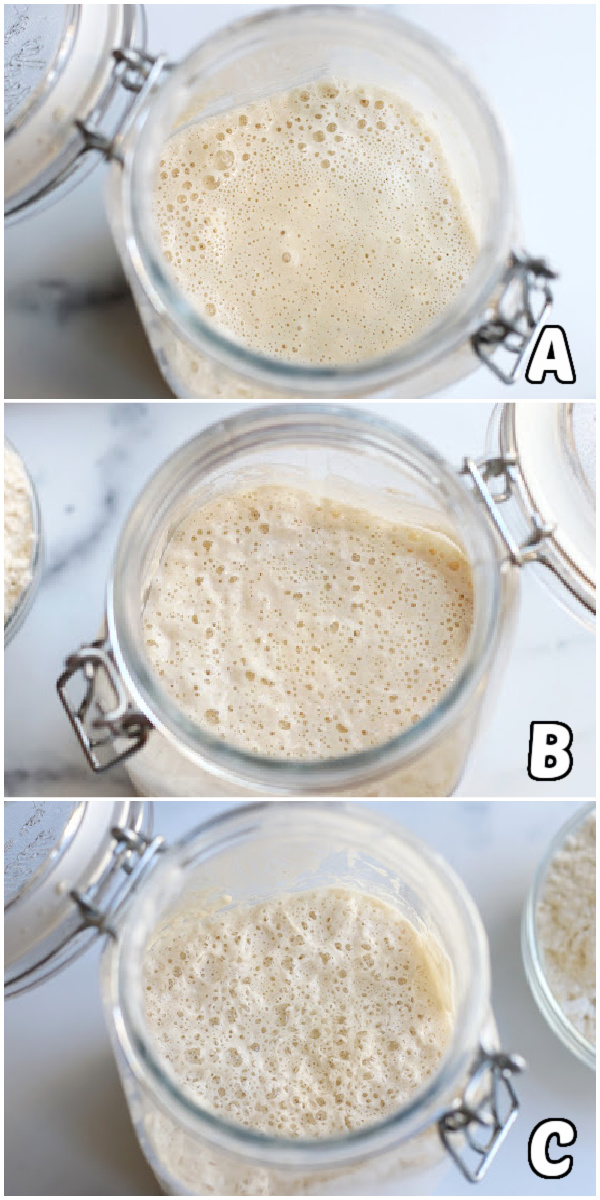
To feed the Sourdough Starter, discard half of it and add 150 grams of flour and 150 grams of water to the remaining Starter. Stir well and let sit at room temperature overnight. If on the second day the Starter has the appearance of photo B, let it sit at room temperature for one additional day before using it in recipes.
Pro Tip#7– If storing the Starter at room temperature it will need to be fed every 2-3 days. If storing in the refrigerator, it can be kept safely for up to 10 days before feeding. Please note that if storing in the refrigerator 2 feedings will most likely be needed before the Starter will look like photo C.
Starter Smell and How to Know if it has Gone Bad
A healthy Sourdough Starter is going to smell sour. Therefore, it is not the best way to judge whether it has gone bad. However, the best way to know is by its appearance. If there are any visible signs of mold or red/orange spots it is time to throw the Starter out and begin again. Take heart though, Sourdough Starters are full of good bacteria. Because of this, chances of it going bad are much lower.
Maintaining Sourdough Starter
For anyone new to sourdough baking, it is incredibly normal to have many questions and concerns about maintaining your sourdough starter. How To Maintain Sourdough Starter has a complete breakdown of the feeding schedule, common concerns and questions so that you can enjoy your sourdough starter for decades to come.
If you enjoyed this Sourdough Starter please let me know by leaving a comment and review below. Doing so helps to encourage others to make the recipe also. Thank you!
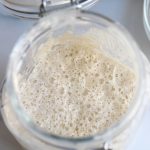
Easy Sourdough Starter
Ingredients
- 700 grams white all-purpose flour *see Note #1 below
- 700 grams filtered water
Instructions
Day 1
- In a medium sized glass bowl mix together 50 grams of water and 50 grams of flour. Stir well and cover. Let sit at room temperature.See Note #2 and Note #3 below.
Day 2
- To yesterday’s mixture add 50 grams of flour and 50 grams of water. Stir well and cover. Let sit at room temperature.
Day 3
- Throw away half of the Starter. To the remaining Starter add 100 grams of flour and 100 grams of water. Stir well and cover. Let sit at room temperature.See Note #3 below.
Day 4
- Throw away half of the starter. Add 150 grams of flour and 150 grams of water to the bowl and stir well. Cover and let sit at room temperature. See Note #4 below.
Day 5
- Similar to the previous days, throw away half of the Starter and add 150 grams of flour and 150 grams of water. Stir well, cover and let sit at room temperature. See Note #5 below.
Day 6
- Throw away half of the starter and add 200 grams of flour and 200 grams of water. Stir well, cover and let sit at room temperature. See Note #6 below.
Day 7
- On day 7 the Starter should at the least look like photo B above if not like photo C. If it has a similar appearance to photo C, it is ready to use. If it looks like photo B, let it sit at room temperature for one additional day.

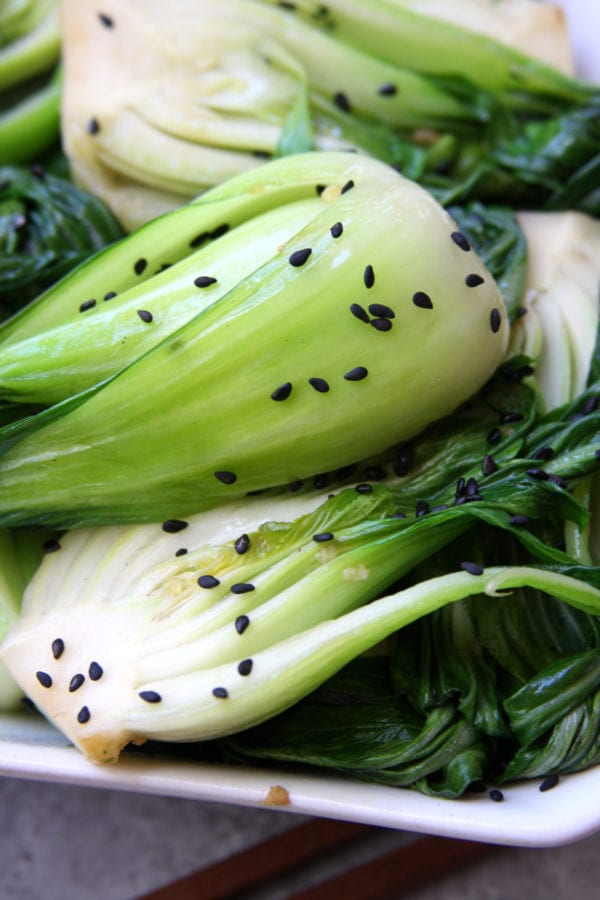

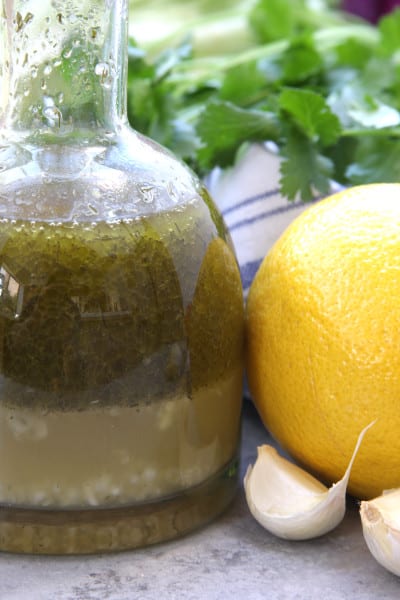
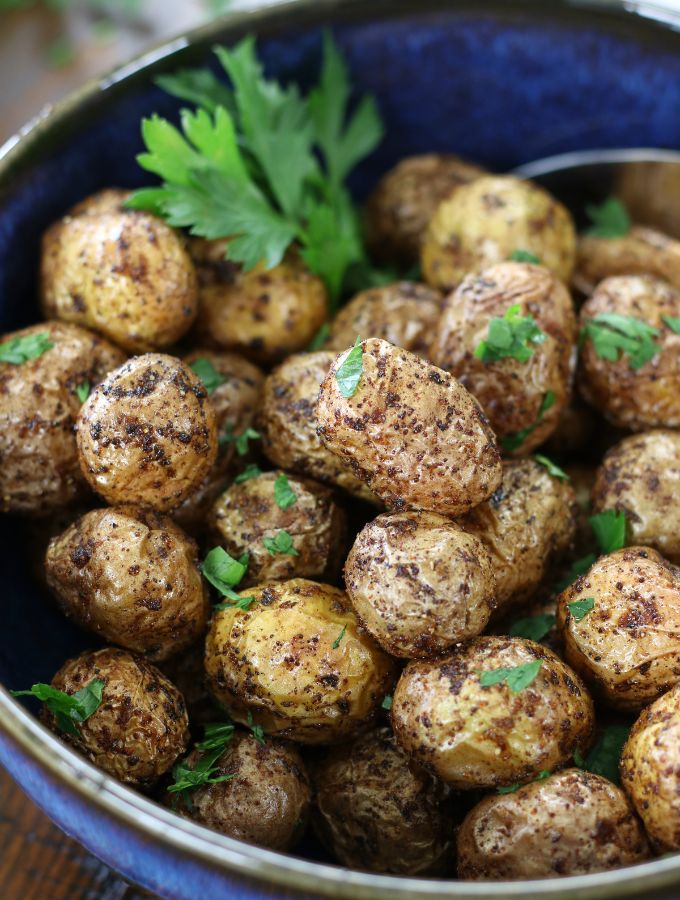

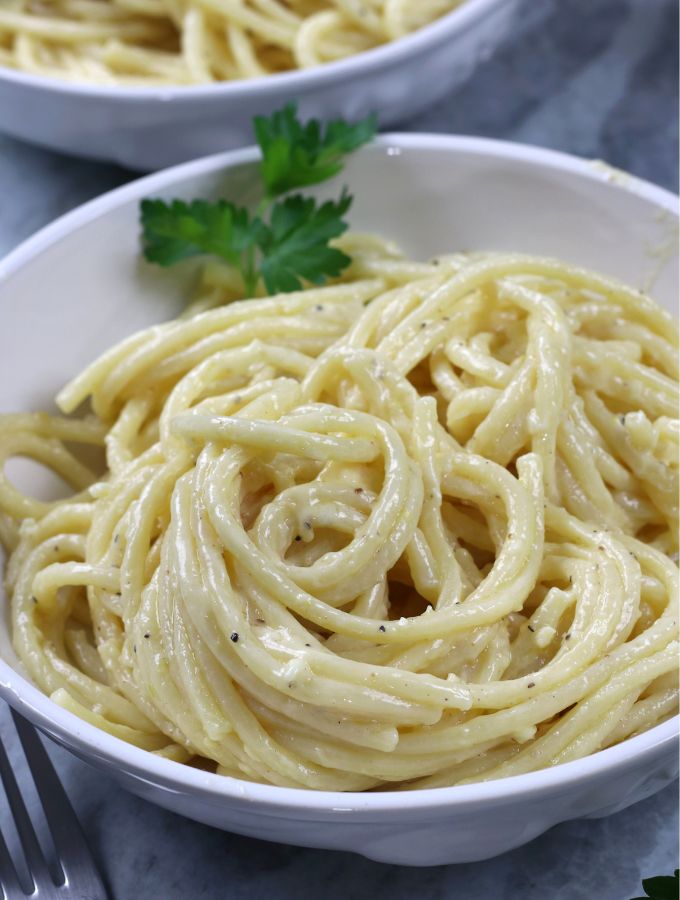
I’m on day 5 and when I open my jar, there is water on top. It smells sour, nut I’m not seeing bubbles like the photo. Have I done something wrong, or should I just keep going?
Hi Amy. This is such great question. The liquid on the top of the starter is called “hooch” (such a crazy name). All it means is that your starter needs to be fed. Simply stir the hooch into the rest of the starter, discard half of it and then feed the starter. It may take a few more days before the bubbles start to form but it sounds like you are on the right path.
Also, I very much appreciate this question because I realize I need to go onto more detail about the hooch.
Thank you for this recipe! I am going to try it. on day 3 instead of throwing away half do you think I can put half in another glass jar and feed this one as well?
Hi Mary. That is a great idea especially if you want to share with family and friends. Once your starter is fully developed, you can use the discard for all kinds of recipes. I don’t have any right now on my site but there are all kinds of fun choices when you google sourdough discard recipes.
Oh darn, I forgot to take half of the starter out when I went to feed it. What do I do now?
No worries at all. Just keep proceeding in the coming days with the plan. It may postpone the process by a day or two but you have not ruined the starter. Keep me updated. I would love to hear how it goes. Happy sourdough making!!!
I’m excited to give this a try! I’ve made the starting batch and expected a soupy consistency but it is thicker. Does that sound correct? I did use a scale and measured in grams.
Hi Shelly. I’m excited for you also. Yes, the starter changes consistency as it sits. When it is bubbly after being fed it will be thicker. After sitting for awhile and not being fed is when it becomes thiner. Basically, sourdough starter has moods based on when it was last fed…much like me. lol!!!
I would love to hear how it turns out.
Hi,
How can we store the starter in the fridge? How often do I need to feed it? Thanks!
I keep my house at about 70 degrees all the time and leave my starter on the counter. I leave it unattended for quite awhile and often it develops the darker liquid (called hooch). When I am ready to use it I stir in the hooch and feed the starter everyday for about 4 days prior to making the dough. As long as the starter doesn’t develop mold, it can last for quite awhile (like 3-4 weeks) without any attention.
This can be applied to refrigeration also. If left unattended, simply pull the starter from the refrigerator about 4-5 days before wanting to make bread, feed everyday and leave on the counter.
When do you switch from glass bowl to glass jar?
Hi Holly. On or around day 5 is usually a good time to switch to the glass jar. Happy Sourdough making!
Do you have a recipe for how to bake it once the starter is done?
I am so glad you asked. Yes, I have sourdough baguettes on the site. I am working on Sourdough French Bread and regular loaves. https://www.thefedupfoodie.com/sourdough-baguettes/
I have started a Sourdough starter with a different recipe 3 times and failed each time. This is by far the best and easiest recipe for a starter I have attempted. I FINALLY have a happy and healthy starter for my sourdough journey. Thank you!
Hi Megan, I am so happy to hear that! Thank you so much for giving it a try. I apologize that I only have sourdough baguette recipe available. Fingers crossed I can get the others up in a timely manner.
Once you have used some of your starter, how much to you feed it to always have a continuous supply of sourdough starter on hand? Do you continue certain day steps for a continuous supply? I love baking bread, so I will probably make a loaf at least once a week.
Thank you!
Jessica
Hi Jessica. This is such a good question. I have gone 3 weeks without feeding it because we had plenty of bread on hand. It does take approximately 3-4 days of feeding the starter for it to become healthy enough to make bread again. In a nutshell, because each starter has a different personality, you will have to go by the appearance of your starter. Making bread once a week may require feeding it for 2-3 days in a row before starting the bread.
I hope this helps and that I didn’t ramble on too much.
I fallow the instructions and now I have sourdow starter . Thank you.
You are very welcome. I hope you enjoy!
Once the starter is established, do you need to dump out half again and how much flour and water would you add each time you feed it to keep it going?
Hi Nicci. Yes, to get the starter ready to make bread it will need to be fed. Depending on how healthy the starter is depends on how many days in a row you will need to feed it. With an established starter I discard half and feed it 150 grams of flour and 150 grams of water. The starter is ready to make bread when it is extra bubbly.
Why do I see the rubber band around peoples jars?
This is such a good question. I use a rubber band when the starter is incredibly healthy and growing like crazy. It basically prevents the glass jar from exploding.
my starter on dayb7 was very watery, I drained off the hooch and fed it…still looks like pancake mix🫤
I am so happy you brought this up. It is super important to not drain the hooch. It is part of what makes the starter healthy. When you see the hooch, mix it in and then proceed with feeding.
It will probably take about 5-7 days of feeding for your current starter that looks like pancake mix to be healthy enough for making bread.
Please let me know how it goes. This stage can be frustrating but you are close to having delicious sourdough.
I followed the instructions but don’t know what to do now. On Day 7 it looked like it needed to sit an additional day at room temp so I am now at Day 8 and it doesn’t look like “C” if anything it has less bubbles. Do I feed it again? Did I do something wrong? Should I start over?
Hi Lisa. You are absolutely on the right track. Each starter has a different personality. Some will take a few days longer. Based on what you are sharing, it sound like you need about 3 more days of feeding.
Please keep me up to date. I would love to hear the progress.
I’m on day 7 and my starter still looks like picture A.. my house is not very warm (we have a pellet stove and the temperature isn’t consistent) could this be a huge issue for me? My room is more consistent and warmer, should I try keeping it in there? Do I continue to discard half and add 150 grams of flour and water each day? Should my lid still loosely be on top or should it be air tight now? Thank you in advance 🙂
Hi Alexandra. Moving your starter to the warmer room is a good idea. Sourdough starters tend to thrive in a consistent, warm environment. Keep up with daily feedings because you are probably closer to a healthy starter than what it feels.
As for the lid, it’s best to keep it loosely covered rather than completely airtight. This allows some airflow and prevents pressure buildup. A tight seal can lead to gas buildup, which might affect the starter. The only time I allow the tight seal is after I have made bread and I am not planning on making bread again for a bit. Once I am ready to make bread again I have to nurture the starter by feeding it for about 4-7 days.
I hope this helps. Please reach out if you have any more questions.
Happy sourdough making!!
Hi Heather!
First timer here! Thank you so much for the easy to follow recipe. I am now on day 5 of my starter and it is starting to look like what is described. I am so excited to make my first loaf!
That makes me so happy to hear. I am very behind on sourdough bread recipes but fingers crossed I can publish them in 2024. Thank you so much for giving the starter recipe a try and happy sourdough baking.
o was just given your recipe for sour dough starter. Have been trying to get one started for two weeks and threw it all out. i just started again so am keeping fingers crossed.
Hi Roslyn. Please do not hesitate to reach out if you have any questions. Sourdough starters are like children, they each have a personality of their own and strong similarities.
Happy sourdough starter making!
My starter looks like B and C so can I use it right away in a recipe? Would I then feed it after I remove the amount recipe calls for?
Thank You!
If it’s full of lots of healthy bubbles like in picture C then yes, you can absolutely use it right away. If there is a little bit of doubt, it never hurts to feed it for one more day.
After removing the amount needed I would feed it through the first few batches of bread. After that you can let it sit and then feed it again a few days before you need it. I hope this makes sense.
Please do not hesitate to reach out as you go with any questions.
I don’t have a scale to measure grams. Can I have the starter recipe in cups instead?
I’m looking forward to start this. Thank you.
Hi Lois. Unfortunately I don’t have it in cups. When making bread, weighing yields consistent results that makes for so much less waste.
I’m on day 6 and I had lots of bubbles, though they were mainly water based on the top and none that I noticed on the sides or inside of the starter. I’m planning to go at least another 2 days. One thing that surprised me was your recipe never called for paying attention to any rise or doubling after the false rise early on. Is it just not going to happen with this recipe?
Once I have it established, what are the next steps in prepping to bake with it?
Hi Sunnie. I apologize for the delay. Thank you for pointing out not including information about the false rise. At the moment I have available the Sourdough Baguette recipe and hope to have the Sourdough French Bread recipe finished soon. https://www.thefedupfoodie.com/sourdough-baguettes/ Also, I will soon be including a post about how to maintain your stater. In short though, I maintain my sourdough starter on the counter, allowing it to sit until I’m prepared to bake bread, and when ready, I feed it for the required number of days to ensure it’s primed for bread-making.
I’m so excited to be doing this! I’m on day 4 and it looks like picture C. I have one that is made with all purpose flour, and one that is made with bread flour. The bread flour one is winning – that’s ok, right? I was hoping I would get a chewier bread. 🙂
You are right on track. Starter can be made with many different types of flour. Each one will have a different personality. I can’t wait to hear which one you like better. Please keep us updated and happy sourdough making!!!